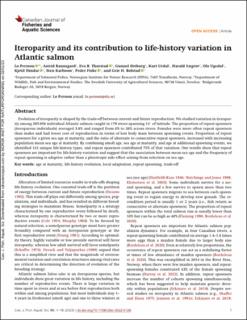| dc.contributor.author | Persson, Lo | |
| dc.contributor.author | Raunsgard, Astrid | |
| dc.contributor.author | Thorstad, Eva Bonsak | |
| dc.contributor.author | Østborg, Gunnel Marie | |
| dc.contributor.author | Urdal, Kurt | |
| dc.contributor.author | Sægrov, Harald | |
| dc.contributor.author | Ugedal, Ola | |
| dc.contributor.author | Hindar, Kjetil | |
| dc.contributor.author | Karlsson, Sten | |
| dc.contributor.author | Fiske, Peder | |
| dc.contributor.author | Bolstad, Geir Hysing | |
| dc.date.accessioned | 2023-02-28T11:58:46Z | |
| dc.date.available | 2023-02-28T11:58:46Z | |
| dc.date.created | 2023-02-08T15:43:22Z | |
| dc.date.issued | 2023 | |
| dc.identifier.citation | Canadian Journal of Fisheries and Aquatic Sciences. 2023, 1-16. | en_US |
| dc.identifier.issn | 0706-652X | |
| dc.identifier.uri | https://hdl.handle.net/11250/3054602 | |
| dc.description.abstract | Evolution of iteroparity is shaped by the trade-off between current and future reproduction.We studied variation in iteroparity among 205 050 individual Atlantic salmon caught in 179 rivers spanning 14◦ of latitude. The proportion of repeat spawners (iteroparous individuals) averaged 3.8% and ranged from 0% to 26% across rivers. Females were more often repeat spawners than males and had lower cost of reproduction in terms of lost body mass between spawning events. Proportion of repeat spawners for a given sea age at maturity, and the ratio of alternate to consecutive repeat spawners, increased with increasing population mean sea age at maturity. By combining smolt age, sea age at maturity, and age at additional spawning events, we identified 141 unique life-history types, and repeat spawners contributed 75% of that variation. Our results show that repeat spawners are important for life-history variation and suggest that the association between mean sea age and the frequency of repeat spawning is adaptive rather than a pleiotropic side effect arising from selection on sea age. age at maturity, life-history evolution, local adaptation, repeat spawning, trade-off | en_US |
| dc.language.iso | eng | en_US |
| dc.rights | Navngivelse 4.0 Internasjonal | * |
| dc.rights.uri | http://creativecommons.org/licenses/by/4.0/deed.no | * |
| dc.subject | age at maturity | en_US |
| dc.subject | life-history evolution | en_US |
| dc.subject | local adaptation | en_US |
| dc.subject | repeat spawning | en_US |
| dc.subject | trade-of | en_US |
| dc.title | Iteroparity and its contribution to life-history variation in Atlantic salmon | en_US |
| dc.title.alternative | Iteroparity and its contribution to life-history variation in Atlantic salmon | en_US |
| dc.type | Peer reviewed | en_US |
| dc.type | Journal article | en_US |
| dc.description.version | publishedVersion | en_US |
| dc.rights.holder | © 2022 The Authors | en_US |
| dc.subject.nsi | VDP::Zoologiske og botaniske fag: 480 | en_US |
| dc.subject.nsi | VDP::Zoology and botany: 480 | en_US |
| dc.source.pagenumber | 1-16 | en_US |
| dc.source.journal | Canadian Journal of Fisheries and Aquatic Sciences | en_US |
| dc.identifier.doi | 10.1139/cjfas-2022-0126 | |
| dc.identifier.cristin | 2124235 | |
| dc.relation.project | Andre: Swedish Research Council FORMAS (grant 2019-01649) | en_US |
| dc.relation.project | Egen institusjon: Norwegian institute for nature research (NINA) | en_US |
| dc.relation.project | Andre: Grieg Seafood ASA | en_US |
| dc.relation.project | Andre: Rådgivende Biologer AS | en_US |
| dc.relation.project | Andre: Statkraft Energi AS | en_US |
| dc.relation.project | Norges forskningsråd: 280308 | en_US |
| dc.relation.project | Norges forskningsråd: 275862 | en_US |
| dc.relation.project | Andre: Norwegian Environment Agency | en_US |
| dc.relation.project | Andre: The power companies in the River Orkla | en_US |
| cristin.ispublished | true | |
| cristin.fulltext | original | |
| cristin.qualitycode | 2 | |

